Interview With Zac Thompson, Writer of No One's Rose
I recently got the chance to talk to Zac Thompson about the release of No One's Rose next month. Co-written with Emily Horn (Click here for our interview with her), illustrated by the talented Alberto Alburquerque, with colours by Raul Angulo and letters by Hassan Otsmane-Elhaou.
No One's Rose is a genre of sci-fi called Solar Punk. It's filled with some incredible concepts and ideas. Not only that but it's exciting, relevant to issues which affect us today, and unusually for a story of its type it's also filled with hope.
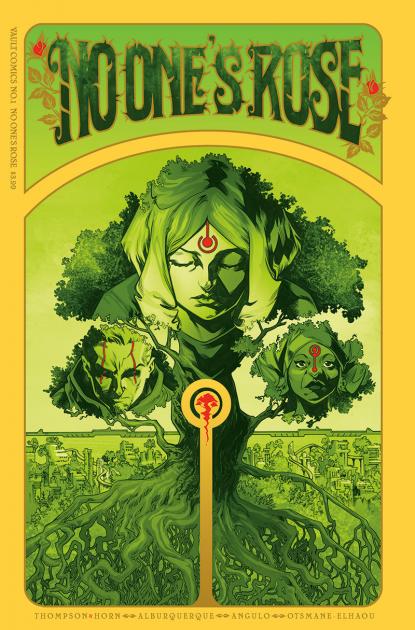
Hi Zac. Thanks for taking the time out of your busy schedule to sit down and talk with CTG. I loved the first issue of No One's Rose. So many great concepts and idea's. One of my favourite things was the way it takes a lot of tropes of the genre and turns them on their head.
You’ve been generous enough to share an early review copy of No One’s Rose #1 with me, but how would you sum it up for our readers who don’t know what to expect?
No One’s Rose is a different type of science fiction book. It’s a book that imagines a hopeful world post catastrophic climate change. We’re dealing with climate change first and foremost to reflect the world we live in. But it’s also in an effort to imagine a different type of fiction. We’re telling a story about people working in harmony with the environment to better the future, to reestablish nature, and working to develop new methods of science that can radically rebuild what was lost.
Moreover, the story is about siblings Tenn and Seren. Who find themselves at odds with how they relate to the world around them. They live inside a massive domed city known as The Green Zone. A fully sustainable utopia that prioritizes plant and animal life. Within this geodesic dome, humanity rebuilds the natural environment while also gaining a breathable atmosphere from a giant bio-engineered tree. Tenn is firmly aligned with the government and believes there is a way to invent a better future, slowly and surely. Seren, however, is determined to build a different future by challenging the injustice he sees within the dome. From those differences, an adventure ensues that threatens to throw the precarious Utopia into disarray along with the future of the human race.
You’ve described this book as Solar Punk. That wasn’t a term I’d come across before and had to google it. How would you explain it in your own words?
Solar Punk is best described as a positive reimagining of our collective future. A future that involves green technology, sustainable practises, tree planting, bio-engineering and much more. It’s essentially a rejection of the doom and gloom that comes with cyberpunk and showing readers something drastically different, soaked in sunlight and powered by renewable energy. People are happy, thriving even, and nature isn’t just a backdrop - it’s an essential part of the world and the lives of those within it.
And moreover, it’s featuring nature in a distinctly “non-anthropromized” way. Showing it exist as it is within the world without having it turn to us and speak directly. All too often we’re treated to talking
animals or plants, which diminish our relationship to the real thing because those characterizations are grounded in fantasy. An idea that a plant or animal is suddenly worth more because we’ve ascribed human qualities to it.
There are a lot of great concepts and worldbuilding in that first issue. You manage to tread that fine line between introducing all these new concepts but still telling the story. How much of a challenge is it to introduce all these new concepts without just being a massive info dump?
Incredibly difficult. There’s a very fine line you have to walk when introducing readers to a new world. It’s all about showing readers about 10% of what you’ve built and hoping they trust you as you go deeper. We made real efforts to ensure that EVERYTHING didn’t get thrown at the reader in the first issue. Instead, everything we’re shown is through the lens of a character. Either Seren or Tenn guides us throughout the series to keep showing us more of their world, and in turn build out more details about the future they inhabit.
We also wanted to ensure that readers weren’t getting giant info dumps as characters spoke to one another in dialogue. Nothing can take me out of a story faster than bad exposition. So, we ensured that everything that characters who live in this world would already know - they don’t say to one another. It’s difficult to resist that impulse, but if you keep the world immersive, readers will intuit most of the details on their own.
Emily and I worked tirelessly to ensure that everything was streamlined and easy to understand. We constantly challenged one another when writing scenes to think of a better/more exciting way to communicate information.
One of the themes I notice both of you talking about a lot in relation to No One’s Rose is hope. Was that a conscious decision from the start? Or did it develop along the way?
This was a conscious decision from the very first time we sat down to build this story 3 years ago. There is a wide array of dystopian science fiction available right now. We’re wallowing in this big glut of it - and we want to reject that idea in every way. There is plenty to be hopeful for, right now in this very moment. And if we don’t start capturing some hope in our fiction people will give into the horrible impulse of giving up.
And that’s especially true when it comes to climate change. We’re very well aware that there is a ton of climate change anxiety in the world right now. And good, we should be worried, we should be activated but we shouldn’t lose hope. No One’s Rose is a reminder that hope is infectious and necessary to address this crisis. We need to start putting more of what we want to see out into the world. It starts by reimagining the way we talk about things. And with this book we’re prioritizing a relationship to the natural world and showing people some of the science and methods we could use to rebuild.
There is obviously a lot of work that’s gone into the worldbuilding in this series and practical solutions to the problems the people in the comic face. Are there aspects of this worldbuilding which won’t make its way into the comics?
Most of it. Realistically, when you’re building a science fiction world you need to consider every single aspect of things before you can tell your story. Perhaps that seems obvious, but you know it comes down to weather, animal life, money, culture, religion, government, where people take a shit, how to bury the dead. It gets pretty granular as you go down, and you can easily be lost in the weeds of it all if you’re not careful.
The key is to communicate only what is absolutely necessary and have the characters live in that world realistically. If you do right by your characters, readers will understand the world as they do. And they’ll be able to piece most of it together.
You’ve talked about this being in the works for three years. Is that a regular timeframe for a project like this?
Every project takes the time it takes. For No One’s Rose, this project actually began as a novel. The scope kept building, and we started talking to the amazing Alberto Jimenez Alburquerque (who had just finished doing a Spider-Man one shot with me at Marvel). We told him a little about the world and he started doing concept art. We knew it had to be a comic. We pitched it to Vault almost 2 years ago and spent a ton of time really hammering out exactly how this was going to work.
In some ways we’re treading new ground here. So we had to ensure we had a super solid framework and honestly taking that kinda time is a luxury you can’t often afford in comics. So I welcomed the development time. It gave Emily and I a lot of opportunities to get into the nitty gritty details of how this domed city would work, and the world it exists within.
I notice you collaborate a lot with other writers. Do you prefer that to writing solo and is there a reason for that?
Writing with others is a ton of fun. It challenges me to step outside my own perspective and approach the unique story in front of me with another pair of eyes. I say this a lot, but co-writing is a lot like writing with an editor in the room. You get to test your ideas on the fly, and scrutinize everything. Which invariably makes the book stronger.
In the case of collaborating with Emily. We had been building this story since we met and when it came time to start pitching the book, I felt really fortunate to have Emily on this project with me. She’s a remarkably gifted writer and has been quietly writing for years, squirreling away incredible prose fiction. So when it came to working on this project she was always ten steps ahead of me. She’s passionate about climate change, writes incredible dialogue, and has a razor sharp story sense.
I love co-writing so much and I love the chance to explore story ideas with another person. Storytelling is an inherently collaborative experience and this is a way for me to turn my social time with people in my life into something incredible.
On the subject of collaboration do you ever have strong differences of opinion? How do you find a compromise?
With any creative project you’re going to have a difference of opinion on how to execute certain things. But that tension creates a palpable sense of discovery that pushes you to find something that works for everyone involved.
Storytelling is all about conflict. So when collaborating it’s always best to take a “yes, and?” approach. You explore everything to its deepest roots to see if it leads anywhere. I’m not a big believer in putting your foot down for something in a story, simply because there really are no “right” answers in storytelling. You gotta learn to flow with it all, and build.
Do you have a preference for writing creator owned properties as opposed to writing someone elses properties?
I adore writing creator-owned books. There is nothing like seeing Alberto and (colorist) Raul Angulo working together to create The Green Zone. Alberto has this wonderful expressive style that effortlessly showcases all kinds of crazy detail. He’s the best collaborator you could ask for on a project like this. He’s passionate about making this place feel alive and kinetic. Meanwhile, Raul has created this really warm and expressive look to the city that makes you feel like you’re living in a giant forest.
There’s something incredible about the freedom when doing creator-owned that I wouldn’t trade for anything. You get to have every piece of the story inform the others. You get to execute a complete creative vision without compromise. And you get to work with superstars while doing it. Everything about this world is meticulously designed. Right down to the lettering choices Hassan makes. Which, for my money, he’s the best letter in comics. Mark my words.
Beyond that, you also get to work with folks who are truly passionate about executing your vision. Adrian Wassel, Damian Wassel, and Tim Daniel at Vault have been truly incredible in helping us create this world. At every turn they’ve been champions of this book and have elevated our ideas in every way. You simply can’t replicate that passion and energy anywhere else. That’s why Vault’s Vault. You can’t separate No One’s Rose from the incredible contributions of the Vault team. And there’s absolutely nothing like having that relentless support and energy behind you, while also doing your own thing.
Thank you for taking the time out of your busy schedule to talk with us. Pre-order No One's Rose #1 here. Check out our review for #1. Find a preview of the first five pages below:
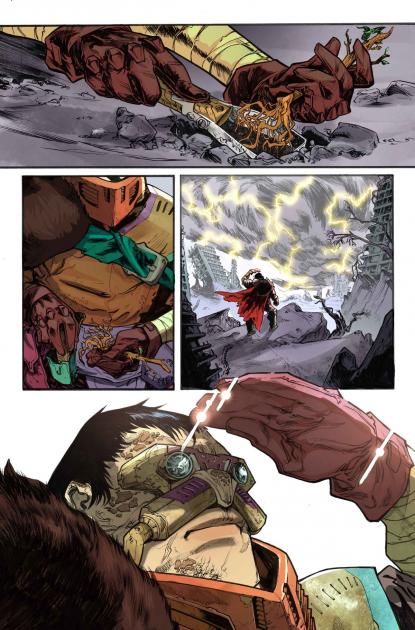
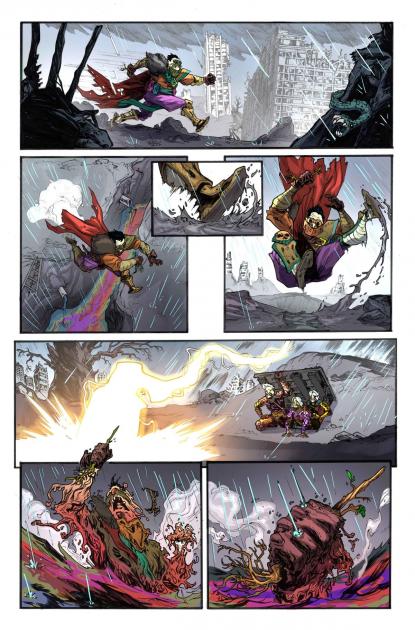
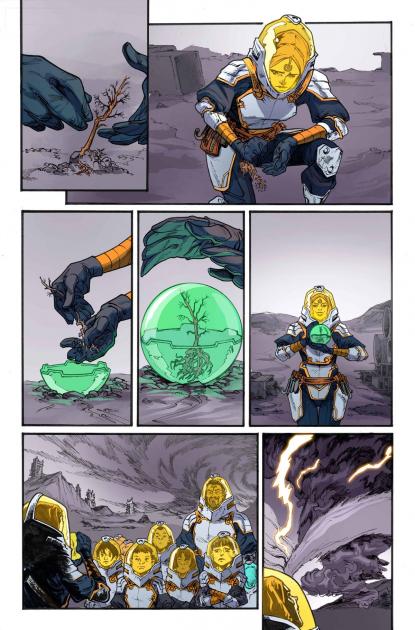

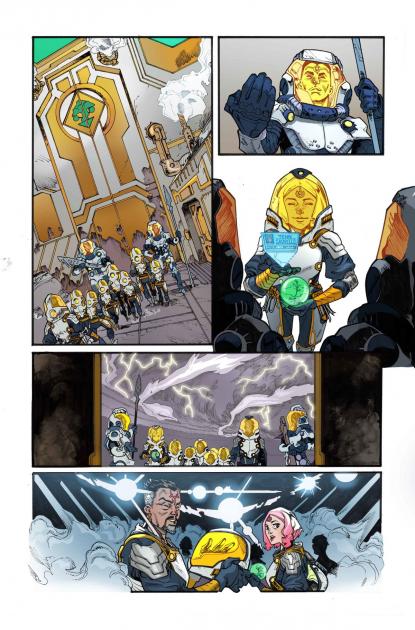
No One's Rose is a genre of sci-fi called Solar Punk. It's filled with some incredible concepts and ideas. Not only that but it's exciting, relevant to issues which affect us today, and unusually for a story of its type it's also filled with hope.

Hi Zac. Thanks for taking the time out of your busy schedule to sit down and talk with CTG. I loved the first issue of No One's Rose. So many great concepts and idea's. One of my favourite things was the way it takes a lot of tropes of the genre and turns them on their head.
You’ve been generous enough to share an early review copy of No One’s Rose #1 with me, but how would you sum it up for our readers who don’t know what to expect?
No One’s Rose is a different type of science fiction book. It’s a book that imagines a hopeful world post catastrophic climate change. We’re dealing with climate change first and foremost to reflect the world we live in. But it’s also in an effort to imagine a different type of fiction. We’re telling a story about people working in harmony with the environment to better the future, to reestablish nature, and working to develop new methods of science that can radically rebuild what was lost.
Moreover, the story is about siblings Tenn and Seren. Who find themselves at odds with how they relate to the world around them. They live inside a massive domed city known as The Green Zone. A fully sustainable utopia that prioritizes plant and animal life. Within this geodesic dome, humanity rebuilds the natural environment while also gaining a breathable atmosphere from a giant bio-engineered tree. Tenn is firmly aligned with the government and believes there is a way to invent a better future, slowly and surely. Seren, however, is determined to build a different future by challenging the injustice he sees within the dome. From those differences, an adventure ensues that threatens to throw the precarious Utopia into disarray along with the future of the human race.
You’ve described this book as Solar Punk. That wasn’t a term I’d come across before and had to google it. How would you explain it in your own words?
Solar Punk is best described as a positive reimagining of our collective future. A future that involves green technology, sustainable practises, tree planting, bio-engineering and much more. It’s essentially a rejection of the doom and gloom that comes with cyberpunk and showing readers something drastically different, soaked in sunlight and powered by renewable energy. People are happy, thriving even, and nature isn’t just a backdrop - it’s an essential part of the world and the lives of those within it.
And moreover, it’s featuring nature in a distinctly “non-anthropromized” way. Showing it exist as it is within the world without having it turn to us and speak directly. All too often we’re treated to talking
animals or plants, which diminish our relationship to the real thing because those characterizations are grounded in fantasy. An idea that a plant or animal is suddenly worth more because we’ve ascribed human qualities to it.
There are a lot of great concepts and worldbuilding in that first issue. You manage to tread that fine line between introducing all these new concepts but still telling the story. How much of a challenge is it to introduce all these new concepts without just being a massive info dump?
Incredibly difficult. There’s a very fine line you have to walk when introducing readers to a new world. It’s all about showing readers about 10% of what you’ve built and hoping they trust you as you go deeper. We made real efforts to ensure that EVERYTHING didn’t get thrown at the reader in the first issue. Instead, everything we’re shown is through the lens of a character. Either Seren or Tenn guides us throughout the series to keep showing us more of their world, and in turn build out more details about the future they inhabit.
We also wanted to ensure that readers weren’t getting giant info dumps as characters spoke to one another in dialogue. Nothing can take me out of a story faster than bad exposition. So, we ensured that everything that characters who live in this world would already know - they don’t say to one another. It’s difficult to resist that impulse, but if you keep the world immersive, readers will intuit most of the details on their own.
Emily and I worked tirelessly to ensure that everything was streamlined and easy to understand. We constantly challenged one another when writing scenes to think of a better/more exciting way to communicate information.
One of the themes I notice both of you talking about a lot in relation to No One’s Rose is hope. Was that a conscious decision from the start? Or did it develop along the way?
This was a conscious decision from the very first time we sat down to build this story 3 years ago. There is a wide array of dystopian science fiction available right now. We’re wallowing in this big glut of it - and we want to reject that idea in every way. There is plenty to be hopeful for, right now in this very moment. And if we don’t start capturing some hope in our fiction people will give into the horrible impulse of giving up.
And that’s especially true when it comes to climate change. We’re very well aware that there is a ton of climate change anxiety in the world right now. And good, we should be worried, we should be activated but we shouldn’t lose hope. No One’s Rose is a reminder that hope is infectious and necessary to address this crisis. We need to start putting more of what we want to see out into the world. It starts by reimagining the way we talk about things. And with this book we’re prioritizing a relationship to the natural world and showing people some of the science and methods we could use to rebuild.
There is obviously a lot of work that’s gone into the worldbuilding in this series and practical solutions to the problems the people in the comic face. Are there aspects of this worldbuilding which won’t make its way into the comics?
Most of it. Realistically, when you’re building a science fiction world you need to consider every single aspect of things before you can tell your story. Perhaps that seems obvious, but you know it comes down to weather, animal life, money, culture, religion, government, where people take a shit, how to bury the dead. It gets pretty granular as you go down, and you can easily be lost in the weeds of it all if you’re not careful.
The key is to communicate only what is absolutely necessary and have the characters live in that world realistically. If you do right by your characters, readers will understand the world as they do. And they’ll be able to piece most of it together.
You’ve talked about this being in the works for three years. Is that a regular timeframe for a project like this?
Every project takes the time it takes. For No One’s Rose, this project actually began as a novel. The scope kept building, and we started talking to the amazing Alberto Jimenez Alburquerque (who had just finished doing a Spider-Man one shot with me at Marvel). We told him a little about the world and he started doing concept art. We knew it had to be a comic. We pitched it to Vault almost 2 years ago and spent a ton of time really hammering out exactly how this was going to work.
In some ways we’re treading new ground here. So we had to ensure we had a super solid framework and honestly taking that kinda time is a luxury you can’t often afford in comics. So I welcomed the development time. It gave Emily and I a lot of opportunities to get into the nitty gritty details of how this domed city would work, and the world it exists within.
I notice you collaborate a lot with other writers. Do you prefer that to writing solo and is there a reason for that?
Writing with others is a ton of fun. It challenges me to step outside my own perspective and approach the unique story in front of me with another pair of eyes. I say this a lot, but co-writing is a lot like writing with an editor in the room. You get to test your ideas on the fly, and scrutinize everything. Which invariably makes the book stronger.
In the case of collaborating with Emily. We had been building this story since we met and when it came time to start pitching the book, I felt really fortunate to have Emily on this project with me. She’s a remarkably gifted writer and has been quietly writing for years, squirreling away incredible prose fiction. So when it came to working on this project she was always ten steps ahead of me. She’s passionate about climate change, writes incredible dialogue, and has a razor sharp story sense.
I love co-writing so much and I love the chance to explore story ideas with another person. Storytelling is an inherently collaborative experience and this is a way for me to turn my social time with people in my life into something incredible.
On the subject of collaboration do you ever have strong differences of opinion? How do you find a compromise?
With any creative project you’re going to have a difference of opinion on how to execute certain things. But that tension creates a palpable sense of discovery that pushes you to find something that works for everyone involved.
Storytelling is all about conflict. So when collaborating it’s always best to take a “yes, and?” approach. You explore everything to its deepest roots to see if it leads anywhere. I’m not a big believer in putting your foot down for something in a story, simply because there really are no “right” answers in storytelling. You gotta learn to flow with it all, and build.
Do you have a preference for writing creator owned properties as opposed to writing someone elses properties?
I adore writing creator-owned books. There is nothing like seeing Alberto and (colorist) Raul Angulo working together to create The Green Zone. Alberto has this wonderful expressive style that effortlessly showcases all kinds of crazy detail. He’s the best collaborator you could ask for on a project like this. He’s passionate about making this place feel alive and kinetic. Meanwhile, Raul has created this really warm and expressive look to the city that makes you feel like you’re living in a giant forest.
There’s something incredible about the freedom when doing creator-owned that I wouldn’t trade for anything. You get to have every piece of the story inform the others. You get to execute a complete creative vision without compromise. And you get to work with superstars while doing it. Everything about this world is meticulously designed. Right down to the lettering choices Hassan makes. Which, for my money, he’s the best letter in comics. Mark my words.
Beyond that, you also get to work with folks who are truly passionate about executing your vision. Adrian Wassel, Damian Wassel, and Tim Daniel at Vault have been truly incredible in helping us create this world. At every turn they’ve been champions of this book and have elevated our ideas in every way. You simply can’t replicate that passion and energy anywhere else. That’s why Vault’s Vault. You can’t separate No One’s Rose from the incredible contributions of the Vault team. And there’s absolutely nothing like having that relentless support and energy behind you, while also doing your own thing.
Thank you for taking the time out of your busy schedule to talk with us. Pre-order No One's Rose #1 here. Check out our review for #1. Find a preview of the first five pages below:





Comments
- Nick Devonald's blog


